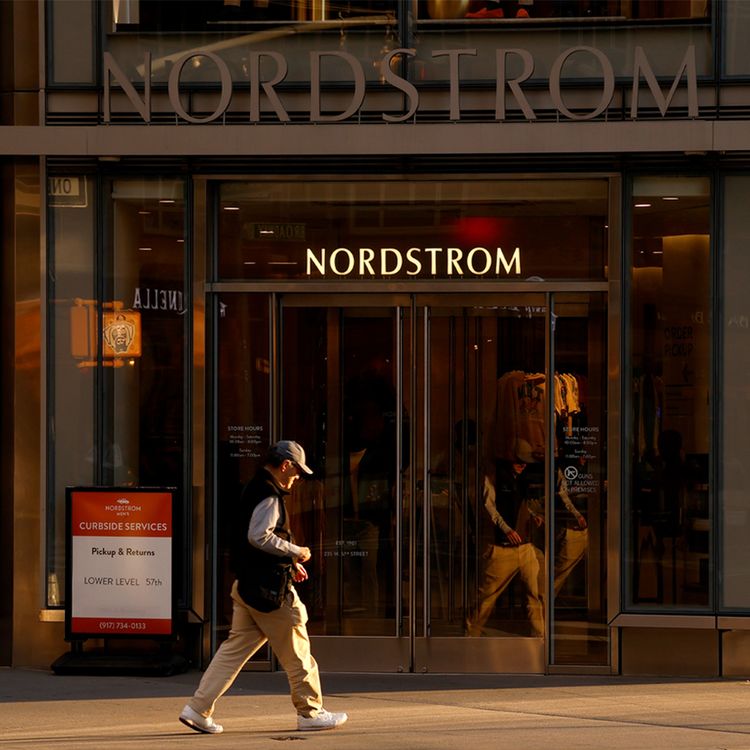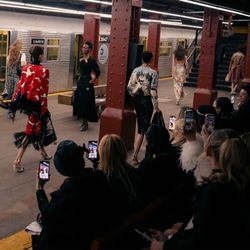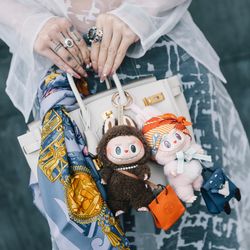Share

The Debrief
Can Department Stores Save Themselves?
For decades, department stores were symbols of American retail success, but their shine has long since faded. Overexpansion that began in the 1990s, the growth of e-commerce and the decline of many malls has left a saturated market, with more stores than there is demand. Major department stores have been struggling for decades to adapt to changes in the way their customers shop, with little to show for it.
"These challenges existed ten years ago, but the problem we have today is that it’s getting later and later, and more and more desperate for these department stores. Time is running out, and they still haven’t figured out the solution,” says retail editor Cat Chen.
In this episode of The Debrief, BoF senior correspondent Sheena Butler-Young speaks with Chen about why department stores are struggling to stay relevant, how activist investors are complicating the picture, and whether following the approach of European department stores like Selfridges can save this iconic segment of the retail industry.
Key Insights:
- Activist investors have been targeting department stores like Macy’s and Kohl’s, but they are more interested in these companies’ real estate portfolios than retail. Chen highlights the parallels with Sears, where the investor Eddie Lampert spun out Sears’ real estate into a separate entity, ultimately leading to its bankruptcy. “The sentiment in the industry is that if these companies were bought out by activist investors it would not be a good sign for the health of these department stores. There wouldn’t be a long-term strategy for maintaining their health,” she says.
- Nordstrom's strategy for revival includes focusing on experiential retail, enhancing customer service, and possibly going private under the Nordstrom family’s ownership. These moves would allow them to invest in the long-term health of the company without the pressure of quarterly earnings. “The Nordstrom family is really set on making some radical, transformative changes to Nordstrom that they just can't make as a public entity,” Chen explains.
- European department stores are a potential model for American department stores to replicate. “Look at Selfridges or look at Le Bon Marché. People love spending time in those stores — tourists but also locals,” Chen says. Explaining how European stores are treated like flagships, with significant investments in customer experience and meticulous attention to detail, she adds, “these companies invest in the layout of the store — fixtures, carpeting, lighting — all of these details matter, and European department stores have done a great job making it happen.”
Additional Resources:
- Why Nordstrom’s Founding Family Wants to Take the Retailer Private | BoF
- Innovation Won’t Save Department Stores. The Right Products Will. | BoF
- Can Saks, Neiman Marcus and Amazon Save the American Department Store? | BoF
More episodes
View all episodes

5 Big Questions About Luxury
30:46|Luxury’s most eventful year in some time is closing with a bang. From Prada’s Versace acquisition to Matthieu Blazy’s debut Chanel Métiers d’Art collection, seismic industry developments are landing on an almost daily basis.In this episode of The Debrief, senior correspondent Sheena Butler-Young and executive editor Brian Baskin are joined by BoF’s Luxury editor Robert Williams, who unpacks all of the industry’s most pertinent news, including the strategic implications of A$AP Rocky’s partnership with Chanel, the rise of the beaten up handbag, and the future of luxury in 2026.Key Insights: The luxury market’s forecast is cautiously optimistic, relying heavily on Chinese consumers and designer-led resets to revive the industry. Brands also need to grapple with justifying value after aggressive price increases in recent years. “Pricing’s certainly going to be an issue and it’s going to be a big issue in the US, which is a really key market for maintaining the brand’s top line,” Williams said.With Prada’s acquisition of Versace closing this week, it remains unclear as to whether the brand will continue with Dario Vitale’s new approach to Versace, or steer towards a more classic, glossy aesthetic. “[Versace] has gone through a pretty radical shift over the past couple of months and whether or not [Prada’s] going to want to continue with that is the biggest most urgent decision, and for them to clarify that for the market,” Williams said.Luxury dining is becoming increasingly popular across the world, but can luxury chains like Langosteria remain cool as they expand? “Fashion once upon a time was all made by your local tailor, your local couturier, and once they decided they could scale taste, that was more desirable than just having something that was more small-scale … In food it seems like it’s kind of the opposite,” Williams said.Originally inspired by Jane Birkin and Mary-Kate and Ashley Olsen, beaten up bags are everywhere in luxury fashion today. “There’s something about the fact that, no matter how much you wear out that bag and trash it, it’s still not going to break and fall apart. I think it just makes it a really cool style gesture. It shows you’re not someone who just bought into it yesterday,” Williams said.Additional Resources:Prada’s Versace Acquisition Closes, Now the Real Work BeginsHow Beat-Up Bags Became a Luxury Status SymbolBreaking Down Chanel’s A$AP Rocky Partnership
Is This the Year Discount Mania Finally Ends?
27:33|As the holiday shopping season approaches, consumer sentiment is slumping, yet spending is bifurcated – the top end keeps buying while the bottom 80 percent is more cautious. With Black Friday looming, brands are recalibrating promotions around value, desirability and hero products rather than blanket discounts. In luxury, upheaval at several department stores has created white space for rivals to woo high-spending clients through aggressive clienteling and tighter, faster vendor partnerships. In this episode of The Debrief, hosts Brian Baskin and Sheena Butler-Young speak with BoF reporters Cat Chen and Malique Morris about how brands are planning the season.Key Insights: Consumer spending hasn’t vanished, but it’s shifted toward shoppers who still feel flush. As Chen notes, “people are not really feeling rosy about the state of the economy, but the irony is that they’re still spending money.” Since Covid, “spending has been driven by the wealthier segment,” and it’s clear that “what consumers want is value… they want to get a good deal, but they don’t want to buy a cheap product.” For retailers, that means “more sophistication around price architecture” and using AI “to price products perfectly.”“Black Friday–Cyber Monday is not a fix for a mediocre year,” says Morris. Instead, winners are “prioritising desirability over discounts,” introducing “new products specifically for this time” and pushing “hero best-selling product.” The old playbook is out, and “slapping a 50% off everything discount on Instagram is not gonna cut it,” says Morris. In the “age of curation,” even deal-hunters expect editing, storytelling and reasons to stop scrolling.Morris argues that even in a discount-driven moment like Black Friday, shoppers still want offers to feel edited and intentional, and brands are responding with more curated tactics rather than blanket markdowns. “We’re in the age of curation and so even when people are expecting deals, they don’t want to feel like they’re just getting slopped,” says Morris. Tariffs and margin pressure mean many brands cannot afford a race to the bottom, pushing them to plan inventory more carefully, introduce new products specifically for this period and reserve discounts for hero items.Chen explains that this holiday season is especially high stakes for luxury multi-brand retailers because a few big players are stumbling – and everyone else is trying to capitalise. “Saks and SSENSE and Luisa Via Roma are three players that have faced pretty bad challenges this year,” she says. “They have opened up white space for their competitors on healthier financial footing to come in and basically eat their lunch and acquire their customers, acquire their sales.” The response is an aggressive push on clienteling and talent: retailers are not just targeting wealthy individuals, but also the salespeople and stylists who already manage those relationships.Additional Resources:Brands Try to Get the Tone Right for Holiday 2025 | BoF Inside Luxury Retailers’ Bare-Knuckle Fight to Win the Holidays | BoF Black Friday Beauty Goes Beyond the Discount | BoF
Can Fashion Still Meet Its Climate Promises?
30:26|As COP30 gets underway in Belém, a port city on the edge of the Brazilian rainforest, the mood is sober. A decade after the Paris Agreement was adopted internationally to limit global warming, many of the world’s largest fashion companies have fallen short on emissions cuts — and some are moving in the wrong direction, emitting pollutants at an even higher rate than in previous years.In this episode of The Debrief, senior correspondent Sheena Butler-Young and executive editor Brian Baskin are joined by BoF reporters, Sarah Kent and Shayeza Walid, to examine why progress has stalled, how fast-fashion growth is reshaping the landscape, and what practical steps — from decarbonising supply chains to adapting factories to extreme heat — are needed next. Key Insights: Kent says, “I would not say any brand has a credible pathway right now to meet their targets for 2030,” “Even companies that have shown that they’re able to reduce their emissions to date, driving down their carbon footprint over the next five years is going to be harder, more complex and more costly… and really no one company can do that alone.”Kent highlights the industry’s deep structural bind: “The fundamental conflict at the heart of the fashion industry’s climate commitments is that you’ve got a business built on extracting stuff and producing stuff and selling stuff. The more stuff they sell, the better the business does, but the worse the environmental impact is,” “Profitability and sales growth are fundamentally at odds with the environmental commitments companies have made.”Short-term thinking still in the boardroom locks in higher climate impacts, adaptation costs and supply-chain risk. As Kent puts it, “On climate, if you don’t act, you don’t have to make these big investments, and you can keep growing your business and things will trundle along for some time. But the longer you wait to act, the worse the climate impacts you’re going to have to deal with are going to be, and the higher the cost of mitigating them, adapting to them, and trying to continue this business in a climate-constrained world.”Voluntary commitments aren’t enough at fast fashion’s scale. Walid points to Shein: “Shein’s case is very instructive. There’s limits to voluntary commitments, which is what the majority of these brands have made.” She continues, “When the business model is built on speed and volume… it just shows that voluntary commitments are maybe not enough for a fashion brand – especially a brand as big as Shein – to actually tangibly reduce its emissions when its entire business case doesn’t stand for that.”Climate impacts are now serious human and corporate risks. “It’s not just a corporate issue anymore,” says Walid. “People who have the visuals recognise the reality of what’s happening in these factories and the people who are making clothes at the end of the day.” Kent adds: “People who are suffering from heat stress are not as productive… floods are disruptive to production, to logistics, to supply chains. Just because we have not yet seen a major disruption to the apparel supply chain from these climate crises yet is more luck than anything else.”Additional Resources:Can Fashion Still Meet Its Climate Promises? | BoF The Frayed Edge: Is Fashion Quiet Quitting on Climate? | BoF
Why Is Everyone Obsessed With Accessories?
22:06|Colourful charms, Labubu-laden handbags and a ring on every finger – accessories sales are booming. A surge of necklace stacks, playful rings and quirky charms is being driven by Gen Z’s push for personal style, using add-ons to customise minimalist wardrobes on a budget. With apparel prices up, accessories act as “little luxuries” and entry points into brands. Retail is responding, with buyers widening small-leather-goods assortments and e-commerce shoots now styling bags with charms to encourage add-on purchases. BoF reporter Diana Pearl joins The Debrief to unpack what’s fuelling the accessory pile-on, how labels are capitalising on it, and how far the trend can go before the cycle turns. Key Insights: According to Pearl, Gen Z is reaching for accessories as a way to personalise their minimalist wardrobes. “Gen Z, which is really looking to define their sense of personal style, is leaning on accessories to do so, especially because minimalism in clothing is still very popular… but they also wanna have a little more fun and accessories are a way to do that,” she says. Regarding the longevity of this trend, Pearl adds, “I think we'll see a consumer that is primed to think of accessories as a more important part of their wardrobe – not just like a finishing touch, but a core element of it.”The Labubu craze captures the mood of the accessories trend – playful, collective and endlessly customisable. “There’s so many different Labubus. There’s a bit of that thrill of the hunt to try to find the right one. You can add it to an Hermès bag or a $100 leather tote from J. Crew,” says Pearl. For many shoppers, she says, “it really speaks to that desire for fun and adding a personal touch. People want things that make them feel good.”While luxury houses profit from entry-level add-ons, Pearl sees independent makers riding the wave. “I think it probably is helping luxury brands but I think even more than that, it’s helping small brands that really can make these cute accessories that feel distinct and different from what everyone else has, because I think a huge part of this is that quest for personal style, wanting something unique,” says Pearl. Pearl frames the moment as a behavioural shift rather than a transient trend. She argues, “trends go away, but they never fully go away. I think every trend leaves a lasting impact or impression on us. Maybe Labubus, toe rings, and bag charms won’t be quite as popular, but maybe they’ll evolve.” Crucially, “I think that this has unlocked something in people… it will have a lasting after effects of this trend, even if not everybody is wearing five necklaces at once in a year from now.”Additional Resources:How Far Can Fashion’s Accessory Obsession Go? | BoF Why Jewellery Feels Like a Better Deal Than a Handbag | BoFLuxury’s Untapped Opportunity in Men’s Jewellery | BoF
The Human Cost of Trump's Tariffs
25:21|In late August, the US doubled duties on Indian goods to 50 percent, in what President Donald Trump described as a punishment for India’s purchases of Russian oil. Brands reacted immediately, postponing or cancelling orders and leaving factories in hubs like Tiruppur and Bengaluru half-filled. With shifts cut and workers laid off, the shock ricocheted through India’s export economy, exposing how little protection garment workers have while relief talks and trade diplomacy drag on.Senior correspondent Sheena Butler-Young and executive editor Brian Baskin are joined by BoF reporter Shayeza Walid to trace how trade policy in Washington quickly impacted the lives of India’s garment workers. Key Insights: The tariff that came into place at the end of August led some suppliers to feel “punished for something they didn’t have any hand in,” as Walid puts it. She adds: “That penalty was linked to India’s continued purchases of Russian crude oil,” and “it hit very fast because brands immediately reacted to it once the 50 percent came into place.”The disruption hit export hubs first and hardest. With brands reluctant to absorb the shock, factories have been left to “bear the brunt,” passing the pressure onto the most vulnerable link in the system. The result is workers facing furloughs, layoffs and open-ended uncertainty. “These workers are largely migrant workers who… don't have the power to collectively bargain and kind of demand what they have the right to”, says Walid. As a result, migrant garment workers are bearing the brunt through layoffs, furloughs and lost income. The response from Western brands has been silence and arm’s-length accountability, as most work through layers of sub-contractors in India. Walid says that, despite public rhetoric on labour rights, “in practice, there's not anything in place that would fix … these short-term contracts and brands not knowing where subcontracting factories are connecting with suppliers.” During Covid, watchdog pressure pushed some labels to repay cancelled orders, but “at this moment, that’s not something that we’re seeing,” Walid notes. In the meantime, a few large exporters are temporarily absorbing parts of the tariff to keep relationships alive – an approach suppliers themselves say is unsustainable – while smaller factories shut and workers absorb the shock.Beyond geopolitics, commercial terms and supply-chain opacity push risk onto workers. “It’s really the purchasing practice and the way contracts work in the supply chain. In the exporting industry, that leaves workers in this really helpless condition,” says Walid. Complexity of the system also weakens accountability: “It’s really extraordinarily difficult to get data and direct kind of causality from a particular brand,” and in hubs like Tirupur, “subcontracting factories are essentially the main suppliers to these bigger factories because they just get such large volumes.” Additional Resources:India’s Garment Workers Are Paying the Price for Trump’s Tariffs | BoF Trump’s 50% Tariff Sows Fear Inside Indian Apparel Hub | BoF
Would You Let AI Shop for You?
32:27|A new wave of AI shopping agents has emerged as Big Tech and start-ups alike vie for dominance of this new market. OpenAI, Google and Perplexity are experimenting with search-to-checkout, while fashion-specific entrants like Vêtir, Phia and Gensmo are learning users' tastes before recommending and purchasing across retailers. But before they get off the ground, trust, accuracy, privacy and simple usefulness remain open questions.Senior correspondent Sheena Butler-Young and executive editor Brian Baskin are joined by BoF reporter Malique Morris to map the agentic ecommerce landscape. Key Insights: AI shopping agents aim to move beyond static recommendations to truly act on a shopper’s behalf. As Morris explains, “traditional e-commerce has algorithms that recommend items based on what you’ve already browsed or purchased,” whereas “an AI shopping agent is supposed to learn the shopper and can act on their behalf,” handle “very specific prompts” and, ultimately, complete the transaction.Agents are trying to replicate the best in-store experience for the ecommerce space. “They’re supposed to be about replicating the in-store salesperson, surfacing the right piece based on the conversation that you might have,” says Morris. As a result, “it’s not calling for brands to rethink how they’re designing their goods,” but more about tools that “help them sell them better and help them get into the hands of the people who are actually really going to want them.”Early users are avid shoppers who love new technology. Morris doesn’t expect a sudden tipping point, but rather gradual mass adoption. “Agentic commerce is [already] here because the tools are being built and experimentation is happening,” he says. “People are going to be conditioned the same way that they were conditioned when Netflix rolled out their algorithms, the same way TikTok and Instagram have with ‘for you’ pages. It’s here, it’s happening and it’s only going to get more efficient.”While the consumer should benefit from this new suite of AI shopping agents, Morris is blunt about power dynamics: “Outside of ‘the consumer is going to win,’ I think it’s going to be who has the resources to perfect this.” Consolidation is to be expected as many smaller platforms are “probably going to get consumed into an OpenAI or a Google or an Amazon. Those already huge [players] are probably going to be the ultimate winners.”Additional Resources:What It Will Take for Consumers to Let AI Shop For Them | BoF
Does Fashion Still Know What Women Want?
27:27|This fashion month, models walked the tightrope between fantasy and function. On the runway, spectacle was dialled up to 100: Alaïa’s armless “straitjacket” dress, Margiela’s metal mouthpieces, and Jean Paul Gaultier’s naked male body prints were among the pieces to spark a wider debate. Some critics have asked what feels like an obvious question: do designers actually understand — or even care — how women dress in their real lives?BoF’s Diana Pearl and Cat Chen join senior editor Sheena Butler-Young to examine why criticism is intensifying now, the role of authorship and how brands can balance showmanship with wearability.Key Insights: Designers face backlash when spectacle eclipses women’s realities. As Pearl observes, “designers weren’t really designing for actual women — or at worst, designing clothes that felt almost disrespectful.” To Pearl, many runway moments “felt either like it was erasing the woman or immobilising them… like fashion is a form of torture.” Even if looks are “dramatized for the runway,” she says, “there’s still a message being sent” that can be interpreted as designers not respecting women. Chen doesn’t see this season as uniquely outrageous in a vacuum, but says context matters. She adds that criticism hits harder now amid other external circumstances, one of which is that many brands are struggling financially. “The fact that these designers had a commercial incentive to be more resonant with consumers and then created these collections that didn't hit at that level, I think that made these collections so much more perceptible to be criticised in this way,” says Chen. Body diversity is the more urgent gap to fix. Pearl says the ultra-thin casting “adds insult to injury… a parade of models that are all extremely thin and… unattainable,” compounding the sense that runways aren’t made with real women in mind. Chen goes further: “the lack of body diversity on the runway is a huge problem,” noting data that shows representation “falling straight down from 2023 to 2025.”Pearl notes perception shifts with who’s in charge: “Women aren’t represented at the top, so it makes us more primed to look at a mouthpiece and feel it’s sexist because it’s coming from a male designer.” Still, she points to shows that balance both: Chanel’s debut “felt very wearable” while staging delivered “otherworldly” theatre, and Khaite’s runways pair mood with pieces that, also, “feel very wearable.” Chen adds that smaller, women-led brands win by staying close to their customer: “It’s really not about spectacle, it’s about being in the same room as their customers.”Additional Resources:Does Fashion Know What Women Want? | BoF Fashion’s Musical Chairs Ends — With Men in Almost Every Seat. | BoF The Emerging Designers Pushing Fashion Forward | BoF
Can a Shop Truly Be a “Third Place”?
26:09|Retailers are racing to repackage shops as “third places” — low-pressure spaces to linger between home and work — as post-pandemic footfall softens and social isolation rises. Sociologist Ray Oldenburg’s original idea centres on civic, low-barrier hubs like cafés and libraries rather than commercial destinations, yet brands are now adding seating, listening bars and in-store cafés to nudge dwell time, loyalty and favourable word of mouth. The best versions use subtle amenities that keep people comfortably in the space, but the sales impact is yet to be proven.In this episode, BoF retail editor Cat Chen joins The Debrief to unpack why scale matters, how to measure success beyond sales, and where third-place experiments risk sliding from community into pure branding.Key Insights: In their efforts to create third places, retailers are utilising food and beverage as subtle amenities that keep people lingering: it’s ‘not about creating food and beverage as a destination, but about simply getting people to spend more time in the store,’” says Chen. Done well, that “authentically [creates] a community,” and “when you have this really positive experience in their ecosystem, you will feel very positively about the brand.” Still, she cautions: “The idea of a third place as a way to drive sales for retailers is an unproven theory.”“Community building is authentic and not a branding exercise,” Chen says. The worst versions of third places feel “branded to death” and designed for photos more than social connection. “At the end of the day, it's not about the social experience of being there, it's about taking a photo of it and being able to consume this luxury brand. That's akin to the first step of being able to afford their $3,000 handbag.” It all goes back to commerce and “is very much the opposite of what Oldenburg meant.” Practical amenities in stores build goodwill. Western outfitter Tecovas’ “radical hospitality” includes a lounge and a free bar inside its store, Sephora succeeds with a hands-off approach when customers are trying samples, and Apple allows patrons to charge their phone or use the bathroom — a small service that leaves a positive halo. As Chen puts it, food and beverage in a third place should be low commitment, cheap and have a low barrier to entry. “There have been a lot of thinkpieces about private members’ clubs popping up in New York and how this is tied to this desire for third places. Private member clubs are not third places, they are the antithesis of third places." Additional Resources:Can a Store Ever Be a ‘Third Place?’ | BoF How Brands Make Community More Than a Buzzword | BoF
Sports x Fashion: Who’s Really Winning?
25:14|From team-branded fashion shows to tunnel-walk capsules and luxury watch deals, sport and fashion are converging at speed. The NFL has rolled smaller licensing tie-ups into marquee partnerships, while the WNBA is emerging as a fertile ground for inventive brand-player collaborations. But alongside the growth is bloat: logo-slap collections, clearance-rack remnants and fuzzy KPIs.Senior correspondent Sheena Butler-Young and executive editor Brian Baskin are joined by BoF sports correspondent Mike Sykes to map the deals that resonate and the ones that miss — and how success of these partnerships are being measured beyond the momentary halo.Key Insights: The WNBA is a collaboration engine because players are the drivers, not passengers. “I think the WNBA right now is a breeding ground for some of these deals in part because the players are eager to find these other opportunities to spread their portfolio,” Sykes says. That unlocks new formats: partnerships “not just between teams and brands or the league and brands, but players themselves and the brands [that] manifest in really cool and unique ways.”Name, Image and Likeness (NIL) has supercharged women’s sports, and fashion is part of the bargaining. Sheena points out the 2021 shift when “college athletes could not monetise their name, image, or likeness” and then stars like “Angel Reese and Caitlin Clark were becoming brands in their own right.” That changes how teams and leagues engage players: “fashion deals can be a bargaining chip on both sides of that equation.”As sports and fashion collaborations become more ubiquitous, authentic propositions are needed to cut through the noise. As Butler-Young puts it, the best examples “take the collections seriously. They treat it like a real fashion product. ‘Anything will do’ – people see through that.” Sykes agrees: “To work with players, you have to work with teams that really want to do things the right way.” It has to make sense for the consumer, and when it doesn’t, the audience calls it out. “The Chelsea and OVO collection was kind of a logo-slap. Even the fans were like, ‘This isn’t it.’” For some brands and athletes involved in these collaborations, partnerships are judged on reach and relevance rather than immediate revenue as the key marker of success. Sykes points to the NFL x Veronica Beard blazers: “There’s still some of that product left and it’s 75 to 80 per cent discounted … you have to look at that as a failure.” Yet the league “takes a holistic view,” he says: even if one capsule doesn’t sell through, lessons on “what you produce, how much, where you produce it, who your core audiences are” feed the next partnership.Additional Resources:Sports and Fashion Are Tighter Than Ever. But Who’s Really Winning? Has Fashion’s Convergence With Sports Gone Too Far? How WNBA Players Are Using Merch to Underscore Their Value